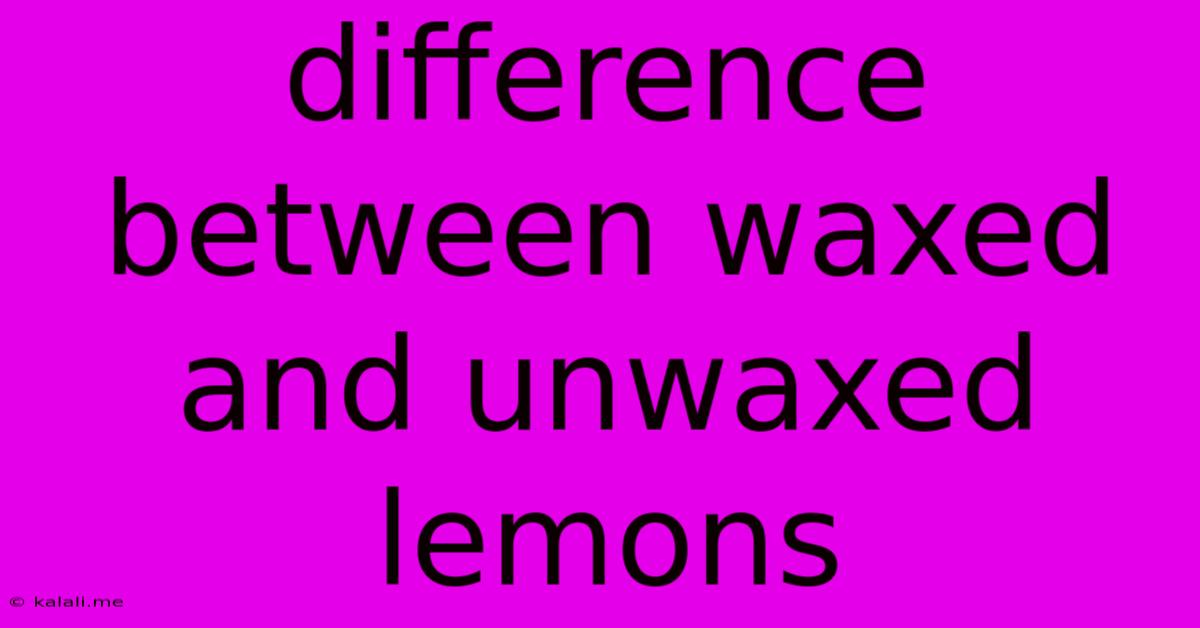Difference Between Waxed And Unwaxed Lemons
Kalali
May 20, 2025 · 3 min read

Table of Contents
Waxed vs. Unwaxed Lemons: What's the Difference and Which Should You Choose?
Choosing between waxed and unwaxed lemons might seem insignificant, but understanding the differences can impact both the flavor of your recipes and your overall health choices. This article will delve into the key distinctions between these two types of lemons, helping you make an informed decision the next time you're at the grocery store. This guide covers everything from appearance and preservation to potential health implications and flavor profiles, ensuring you're well-equipped to select the best lemon for your needs.
What is Lemon Wax?
The waxy coating found on many commercially produced lemons isn't a naturally occurring substance. It's typically a blend of food-grade waxes, including carnauba wax, beeswax, and shellac, applied to enhance the fruit's shelf life and appearance. This protective layer minimizes moisture loss, prevents blemishes, and gives lemons a shiny, appealing finish – making them more attractive to consumers and extending their time on supermarket shelves.
Visual Differences: Waxed vs. Unwaxed Lemons
- Waxed Lemons: Possess a smooth, glossy surface with a noticeable sheen. They often appear more perfect, with fewer blemishes or imperfections.
- Unwaxed Lemons: Have a slightly duller, more matte appearance. They may have some minor imperfections, such as blemishes or slight discoloration. The skin might feel slightly rougher to the touch.
Taste and Flavor:
While the wax itself is generally considered safe for consumption, some people believe it can slightly impact the flavor of the lemon. Many find that unwaxed lemons offer a brighter, more intense lemon flavor, while waxed lemons might have a slightly muted taste. However, this difference is often subtle and may depend on personal preference and the specific lemon variety.
Shelf Life and Preservation:
The primary reason for waxing lemons is to extend their shelf life. Waxed lemons typically last longer than unwaxed lemons, which tend to dry out and spoil more quickly. This is because the wax layer helps retain moisture and protects the fruit from environmental damage.
Health Concerns:
While the wax used on lemons is generally considered safe for consumption by regulatory bodies, some individuals may have concerns regarding potential pesticide residue or the impact of consuming the wax itself. Unwaxed lemons are generally preferred by those seeking to minimize potential exposure to added substances. However, it's crucial to remember that both waxed and unwaxed lemons can be washed thoroughly before use to remove any surface residue.
Choosing Between Waxed and Unwaxed Lemons:
The best choice depends on your priorities:
- For longer shelf life and a perfect appearance: Choose waxed lemons.
- For a potentially brighter flavor and to minimize exposure to added substances: Choose unwaxed lemons.
- For baking or recipes where the zest is used: Consider unwaxed lemons, as the wax might slightly interfere with the zest's flavor.
- For juicing: Both waxed and unwaxed lemons work well, but ensure to thoroughly wash either type before juicing.
Ultimately, the decision rests on your individual preferences and priorities. By understanding the key distinctions between waxed and unwaxed lemons, you can make a more informed choice that aligns with your culinary and health goals.
Latest Posts
Latest Posts
-
What Is Double Of 1 4 Cup
Jul 10, 2025
-
Prepare Me A Body And I Will Redeem Man
Jul 10, 2025
-
How Many Inches Is A Meter Stick
Jul 10, 2025
-
Soundtrack To Step Up 2 The Streets
Jul 10, 2025
-
Keebler Club And Cheddar Crackers Expiration Date
Jul 10, 2025
Related Post
Thank you for visiting our website which covers about Difference Between Waxed And Unwaxed Lemons . We hope the information provided has been useful to you. Feel free to contact us if you have any questions or need further assistance. See you next time and don't miss to bookmark.